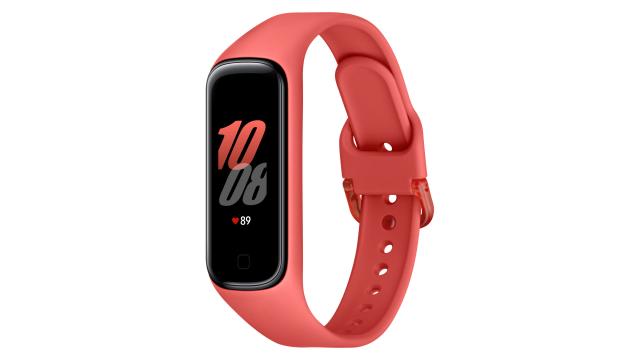I will be the first to say that not everything has to be a smartwatch. In fact, I am relieved that as smartwatches become more affordable, wearables makers haven’t completely forgotten about cheaper options for those of us who want a gadget to track steps without breaking the bank. What I can’t abide is just how boring these trackers have become.
Case in point: Today Samsung announced its Galaxy Fit2 fitness tracker at IFA 2020. It is, for lack of a better phrase, a dinky wristband. It does all the things you expect a fitness band to — it auto-detects five exercises and tracks calories burned, heart rate, distance, and even gives you a sleep score. Samsung says its “groove design” helps reduce sweating and that there are over 70 face designs to choose from on its 1.1-inch AMOLED display. It has 15 days of battery life; 21 if you switch to a power-saving mode. Samsung had zero information about pricing and availability, but I’d be surprised if this was more than $200.
Three years ago, I might have been excited about the Galaxy Fit2. Now, I can’t help but look at it and feel this was a fitness band cynically farted out to keep Samsung alive in the budget wearable space.
[referenced id=”1259093″ url=”https://gizmodo.com.au/2020/08/the-samsung-galaxy-watch-3-is-the-android-smartwatch-ive-been-waiting-for/” thumb=”https://gizmodo.com.au/wp-content/uploads/2020/08/19/xsizo9foofoey0e5acic-300×169.jpg” title=”The Samsung Galaxy Watch 3 Is the Android Smartwatch I’ve Been Waiting For” excerpt=”I’ve been searching for years for an Android smartwatch that I could confidently recommend as being as good as, if not better than, the Apple Watch. Well, the search is over. The Samsung Galaxy Watch 3 is that smartwatch.”]
I appreciate that a lot of people want only the basics, done well. But these days the main innovations on the fitness band front seem to be falling prices and longer battery life. Take the recently updated Fitbit Inspire 2. The headline-grabbing stuff all went to its flagship smartwatches, the Fitbit Sense and Versa 3. The Fitbit Inspire 2 seemed a bit tacked on and the main thing of note was that it promised 10 days of battery life. That… was basically it.
Simple trackers don’t have to be so devoid of creativity. Even if you keep the hardware relatively bare-bones, there’s plenty to innovate on in terms of software, design, and form factor.
Take design. I thought it was bad that several smartwatches ape the Apple Watch’s look, but fitness bands are equally bad with their oblong screens and chintzy silicone straps. In the early days of fitness tracking, fitness trackers weren’t always chained to your wrist. Some companies, like Bellabeat and Ringly, at least attempted different form factors like bracelets, necklaces, rings, and even just as discreet clip-ons. While Ringly is no longer in the game, it was sort of cool that on top of activity tracking, you got a chic wearable that was also capable of delivering notifications. Bellabeat’s trackers are also notable in that they were among the first to include period tracking. The main issue with these more fashionable tracking options was that they weren’t super accurate and were often more expensive than necessary.
That said, wearable tech has gotten more advanced in subsequent years. Are you really telling me that companies like Fitbit, Samsung, Xiaomi, and others in the budget space aren’t capable of adapting wearable tech to less-tired designs? Are you really saying that if you want an affordable tracker, your main options are iterations on brightly coloured, flimsy silicone bands?
Simpler smart rings would be a great start. Just as not everyone wants a smartwatch, I imagine not everyone needs or wants a display on their tracker either. After a few weeks of wearing the Oura Ring, I also remembered how smart rings are way more comfortable than wristbands for 24/7 wear. The Oura Ring — and other smart rings I’ve tried, like the now-defunct Motiv Ring — were also capable of fairly advanced heart rate, sleep, and recovery tracking. They aren’t the most precise, but then again, in my testing, many simpler wrist-based fitness trackers aren’t the most accurate either. The price point on smart rings isn’t quite as attractive, but without more competition and innovation on this front, how can it be?
The other issue is that as smartwatches become more affordable, there’s less of a reason to get a basic tracker. Huami’s Amazfit smartwatches may not come with the best fitness-tracking app, but it’s also hard to argue with their extremely long battery life and sub-$150 prices. You can see this problem with the Fitbit Charge series too. Beginning with the Charge 3, these trackers began taking on more smartwatch-y features to the point where it was hard to argue why anyone shouldn’t spend the extra $50 for one of the various Versa smartwatches — which also had more responsive screens.
I’m all for affordable fitness-tracking options, but companies can’t keep stuffing more battery life into these bands without providing more value with regard to the data they provide, bolstering build quality, and rethinking the possibilities with regard to form factor. It’s just such a waste.
